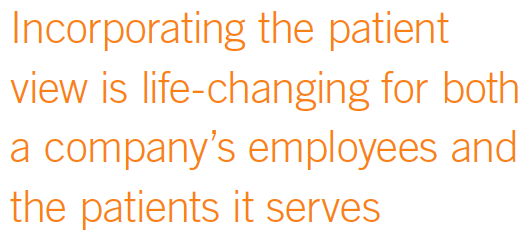What Does Patient Centricity Look Like?
Pharmaceutical Executive
That often-muddled picture is becoming increasingly clearer in the patient and business context as different ways in which patients, patient communities, advocacy, and pharma engage each other converge.
For people with no experience in pharma, it seems very odd that an industry that makes drugs and therapies that treat, cure, or relieve the symptoms of diseases in people actually may not have a “patient-first” view. Observers don’t see the doctor as a gatekeeper to a prescription, or a pharmacy benefit management company as a drug controller, or even laws and regulations that ensure undue influence is not a factor when
Lisa Henderson

a patient is educated about a drug. However, those factors do create a history and a muddiness in reaching out to patients as a true “consumer.” But what is more apparent in the past 10 or so years, is that a patient-first mentality incorporated into a biopharmaceutical organization can create a beneficial environment for both the patient and the company.
It’s one thing to say you are patient centric but how do you actually live it?” That question is posed by John Crowley, chairman and CEO of Amicus Therapeutics, in this month’s cover executive profile. Crowley answers with how the patient-centric processes is incorporated into Amicus, which operates in the rare disease space. Crowley’s philosophies are informed through his life and career path, starting a biotech company that researched and developed drugs for Pompe disease, a protein enzyme deficiency that results in muscular degeneration. It’s the disease two of his children were diagnosed with in 1998. Now Crowley is at Amicus, with a recently launched therapy, Galafold, for another rare disorder, Fabry disease.
What is clear from Crowley’s interview is that incorporating the patient view is life-changing for both a company’s employees and the patients it serves. In this article, based on survey results from biopharma professionals responsible for “patient” functions, it finds that employees have greater job satisfaction and appreciation for their work when they know their work positively affects others. Patient services providers, who operate “call centers” or hub services for patients, are bringing more patients and their stories into their daily interactions and as a result feel better about their jobs and more connected to their patients (view here).
There are barriers to patient-centric success. One is C-suite buy-in and support. Many patient professionals feel that their role is difficult to quantify because of a lack of accountability or clear metrics from executives and senior management. As this function has grown, and as the survey article shows, many feel that training employees in biopharma on patient centricity is lacking. In fact, 69% are struggling with what and how to teach patient centricity to employees.
These barriers are being tackled by The Aurora Project benchmarking project mentioned, as well as a DIA working group investigating the patient and their role in pharma. Amicus Chief Patient Advocate Jayne Gershkowitz helped cofound a nonprofit organization, Professional Patient Advocates in Life Sciences

(PPALS, ppals.org), which, in conjunction with Sanford Research Institute, created the Patient Advocacy Certificate Training (PACT) course of study “for health and life science professionals and leaders of patient advocacy organizations to enhance their professional development.” Gershkowitz notes in our article, “It’s about validating the arrival of patient advocacy in life sciences.”
Like biopharma, where maybe the smaller, rare disease-focused companies have more of a natural foothold with the patient community, patient advocacy groups themselves range from very inexperienced one-person entities, to large, multifunction patient advocacy groups. John Novack, director of communications for Inspire, says that advocacy groups very much run the gamut on the ways they work with pharma. Inspire, which started in 2005, has more than 100 national patient organization partnerships and over one million members in its patient engagement platform. It recently released its fourth annual survey called Insights from Engaged Patients, which explores how patients see physicians, what social media platforms they use, their educational resources, and more (view here).
Increasingly, as the multiple ways in which patients engage with each other, advocacy and communities, and pharma converge, the answer to “What Does Patient Centricity Look Like?” will become more clear and more readily explainable.
Lisa Henderson is Editor-in-Chief of Pharm Exec. She can be reached at lisa.henderson@ubm.com. Follow Lisa on Twitter: @trialsonline

Addressing Disparities in Psoriasis Trials: Takeda's Strategies for Inclusivity in Clinical Research
April 14th 2025LaShell Robinson, Head of Global Feasibility and Trial Equity at Takeda, speaks about the company's strategies to engage patients in underrepresented populations in its phase III psoriasis trials.